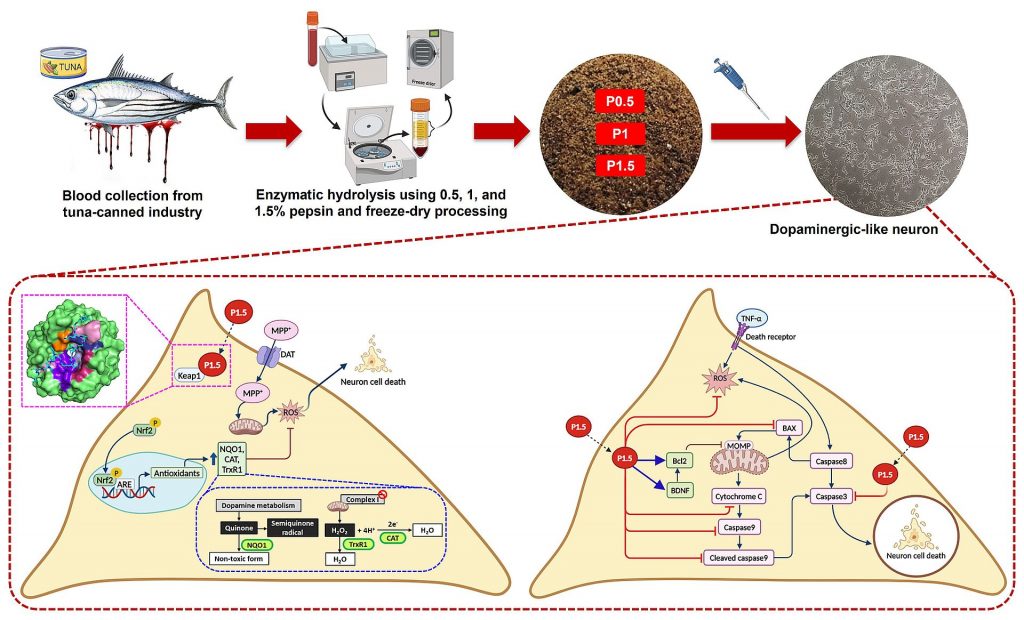
Highlight
TBH alleviates MPP+ and TNF-α-induced cell death in differentiated SH-SY5Y cells.
ที่มาและความสำคัญ
พยาธิสรีรวิทยาของโรคพาร์กินสันเชื่อมโยงกับความเครียดจากปฏิกิริยาออกซิเดชั่นและการอักเสบในสมองจนกระทั่งทำให้เกิดการตายของเซลล์ประสาทชนิดโดปามิเนอร์จิคในสมองส่วน substantia nigra pars compacta (SNpc) การรักษาโรคพาร์กินสันในปัจจุบันคือการใช้ยาบรรเทาอาการ เช่น ยาเลโวโดปา แต่ยาหลายๆชนิดนี้ยังไม่สามารถรักษาโรคนี้ให้หายขาดได้ นอกจากนี้การใช้ยาในระยะยาวอาจนำไปสู่ผลข้างเคียงได้ ดังนั้นการวิจัยในปัจจุบันจึงเน้นที่จะใช้ผลิตภัณฑ์จากธรรมชาติมาใช้เป็นทางเลือกในการบรรเทาอาการหรือรักษาโรคพาร์กินสันหรือโรคทางระบบประสาทอื่นๆ เนื่องจากอาจจะไม่ก่อให้เกิดผลข้างเคียงหรือเกิดผลข้างเคียงได้น้อย ในระยะหลังๆนี้มีงานวิจัยหลายชิ้นรายงานว่า โปรตีนไฮโดรไลเสตจากปลามีสารต้านอนุมูลอิสระ และคุณสมบัติต่อต้านการอักเสบและลดตายของเซลล์หลายชนิด ซึ่งรวมถึงเซลล์ประสาท ดังนั้นการศึกษานี้มีวัตถุประสงค์เพื่อตรวจสอบฤทธิ์ต้านอนุมูลอิสระและฤทธิ์ต้านการอักเสบของเลือดปาทูน่าเลือดไฮโดรไลเซท (TBH) ในการบรรเทาการตายของเซลล์ประสาทนิวโรบลาสโตมาของมนุษย์ (SH-SY5Y) ที่ได้รับการกระตุ้นการเปลี่ยนแปลงไปเป็นเซลล์ประสาทที่คล้ายเซลล์ประสาทชนิดโดปามิเนอร์จิก (differentiated SH-SY5Y) ในแง่ของการลดการตายของเซลล์ โดยลดอนุมูลอิสระและลดการอักเสบภายในเซลล์
Abstract
The pathophysiology of Parkinson’s disease (PD) is linked to oxidative stress and inflammatory-induced cell death of dopaminergic neurons in substantia nigra pars compacta (SNpc). The current study aims to investigate the effects of tuna blood hydrolysate (TBH) on the neurodegeneration of Parkinson-like disease models using neurotoxin-induced SH-SY5Y cells differentiated to be dopaminergic-like neurons. It was found that TBH at concentrations ranging from 5 to 250 µg/ml can reduce differentiated SH-SY5Y cell death after exposure to 1-methyl-4-phenylpyridinium (MPP+) co-treated with TBH for 24 h. Real-time PCR results indicated that TBH enhanced the expressions of NAD(P)H quinone dehydrogenase 1 (NQO1), catalase (CAT), and thioredoxin reductase (TrxR1), which are Nrf2 downstream antioxidant genes. Bioinformatic analysis and molecular docking revealed that the peptide found in TBH, IPGQPGLPGPPGPPGPPGLG, could penetrate the cell and blood–brain barrier and strongly bind the Keap1-Kelch domain, causing Nrf2 nuclear translocation. Consequently, the upregulation of antioxidant genes ameliorates ROS and reduces dopaminergic neuron death. Another, TBH can reduce differentiated SH-SY5Y cell death and intracellular ROS after exposure to 24 h of co-treatment between TBH and tumor necrosis factor-alpha (TNF-α). Western blot analysis was performed to investigate apoptosis-related proteins. Bcl2 and BDNF are dramatically increased, while BAX, cytochrome c, caspase3, caspase9, and cleaved caspase9 are significantly decreased in co-treating differentiated SH-SY5Y cells with TBH and TNF-α. These findings demonstrated that TBH can suppress the apoptosis of inflammatory differentiated SH-SY5Y cells. Taken together, this study suggests that TBH can alleviate neurodegeneration and has anti-inflammatory effects on dopaminergic-like neurons in the simulation of a PD condition.
KEYWORDS: Parkinson’s disease, MPP+, Nrf2, Keap1-Kelch domain, TNF-α, Tuna blood hydrolysate
Citation: Rungruang, P., Rodthayoy, D., Hawangjoo, M., Klaypradit, W., Chonpathompikunlert, P., Sansri, V., … & Sroyraya, M. (2024). Alleviative and Anti-Inflammatory effects of tuna blood hydrolysates on MPP+ and TNF-α-induced Parkinson-Like disease model through the regulation of Keap1-Nrf2 antioxidant pathway and apoptosis. Journal of Functional Foods, 116, 106134. https://doi.org/10.1016/j.jff.2024.106134
RELATED SDGs:
SDG Goal หลัก ที่เกี่ยวข้อง
3. GOOD HEALTH AND WELL-BEING

ผู้ให้ข้อมูล: ผู้ช่วยศาสตราจารย์ ดร.มรกต สร้อยระย้า
ชื่ออาจารย์ที่ทำวิจัย: ผู้ช่วยศาสตราจารย์ ดร.มรกต สร้อยระย้า
ชื่อนักศึกษาที่ทำวิจัย: Panlekha Rungruang, Daraphan Rodthayoy
Credit ภาพ: ผู้ช่วยศาสตราจารย์ ดร.มรกต สร้อยระย้า
Tags: Keap1-Kelch domain, MPP+, Nrf2, Parkinson’s Disease, TNF-α, Tuna blood hydrolysate
